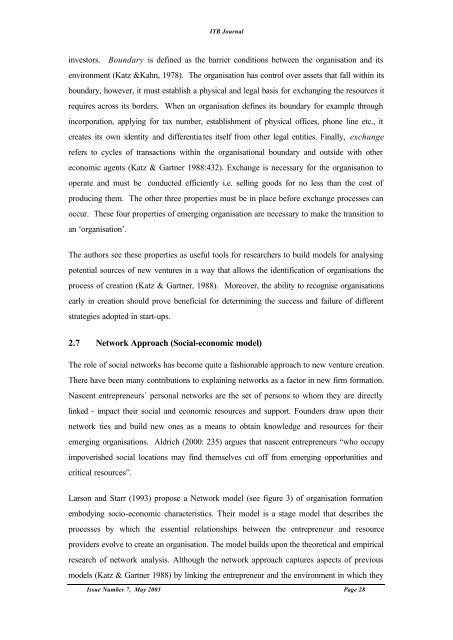ITB Journal-May-2003 - Institute of Technology Blanchardstown
ITB Journal-May-2003 - Institute of Technology Blanchardstown
ITB Journal-May-2003 - Institute of Technology Blanchardstown
You also want an ePaper? Increase the reach of your titles
YUMPU automatically turns print PDFs into web optimized ePapers that Google loves.
<strong>ITB</strong> <strong>Journal</strong><br />
investors. Boundary is defined as the barrier conditions between the organisation and its<br />
environment (Katz &Kahn, 1978). The organisation has control over assets that fall within its<br />
boundary, however, it must establish a physical and legal basis for exchanging the resources it<br />
requires across its borders. When an organisation defines its boundary for example through<br />
incorporation, applying for tax number, establishment <strong>of</strong> physical <strong>of</strong>fices, phone line etc., it<br />
creates its own identity and differentiates itself from other legal entities. Finally, exchange<br />
refers to cycles <strong>of</strong> transactions within the organisational boundary and outside with other<br />
economic agents (Katz & Gartner 1988:432). Exchange is necessary for the organisation to<br />
operate and must be conducted efficiently i.e. selling goods for no less than the cost <strong>of</strong><br />
producing them. The other three properties must be in place before exchange processes can<br />
occur. These four properties <strong>of</strong> emerging organisation are necessary to make the transition to<br />
an ‘organisation’.<br />
The authors see these properties as useful tools for researchers to build models for analysing<br />
potential sources <strong>of</strong> new ventures in a way that allows the identification <strong>of</strong> organisations the<br />
process <strong>of</strong> creation (Katz & Gartner, 1988). Moreover, the ability to recognise organisations<br />
early in creation should prove beneficial for determining the success and failure <strong>of</strong> different<br />
strategies adopted in start-ups.<br />
2.7 Network Approach (Social-economic model)<br />
The role <strong>of</strong> social networks has become quite a fashionable approach to new venture creation.<br />
There have been many contributions to explaining networks as a factor in new firm formation.<br />
Nascent entrepreneurs´ personal networks are the set <strong>of</strong> persons to whom they are directly<br />
linked - impact their social and economic resources and support. Founders draw upon their<br />
network ties and build new ones as a means to obtain knowledge and resources for their<br />
emerging organisations. Aldrich (2000: 235) argues that nascent entrepreneurs “who occupy<br />
impoverished social locations may find themselves cut <strong>of</strong>f from emerging opportunities and<br />
critical resources”.<br />
Larson and Starr (1993) propose a Network model (see figure 3) <strong>of</strong> organisation formation<br />
embodying socio-economic characteristics. Their model is a stage model that describes the<br />
processes by which the essential relationships between the entrepreneur and resource<br />
providers evolve to create an organisation. The model builds upon the theoretical and empirical<br />
research <strong>of</strong> network analysis. Although the network approach captures aspects <strong>of</strong> previous<br />
models (Katz & Gartner 1988) by linking the entrepreneur and the environment in which they<br />
Issue Number 7, <strong>May</strong> <strong>2003</strong> Page 28
















